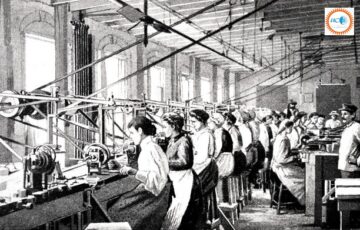Industrial Revolution
Q. How did the Industrial Revolution impact society and the economy in Europe and North America?
- The Industrial Revolution was a period of great transformation that impacted the society and economy in Europe and North America. This period saw a significant shift in the way people worked, lived, and interacted with each other. The revolution transformed the economies of both regions and led to the emergence of new technologies, new social classes, and new ways of life.
- The Industrial Revolution began in the late 18th century and continued into the 19th century. It started in Britain and quickly spread to other parts of Europe and North America. The revolution brought about major changes in agriculture, transportation, communication, and manufacturing. The following are the key impacts of the Industrial Revolution on society and the economy:
- The Rise of the Factory System: The Industrial Revolution saw the rise of the factory system in Europe and North America. This led to the growth of urban areas, as people moved from rural areas to work in factories.
- The factory system brought about significant changes in the way goods were produced, as machines replaced human labor. This led to increased efficiency and productivity, which in turn led to the growth of the economy.
- The Emergence of New Social Classes: The Industrial Revolution led to the emergence of new social classes in Europe and North America.
- The factory owners and capitalists became the new elite, while the working class and the poor became the new underclass.
- This led to significant social and economic disparities, with the rich becoming richer and the poor becoming poorer.
- Increased Trade and Globalization: The Industrial Revolution led to increased trade and globalization in Europe and North America.
- New technologies such as steam engines and railroads made it easier to transport goods and people across long distances.
- This led to increased trade between different regions, and the growth of international trade.
- Technological Advancements: The Industrial Revolution saw significant technological advancements in Europe and North America.
- New inventions such as the spinning jenny, power loom, and steam engine revolutionized the way goods were produced.
- This led to increased efficiency and productivity, which in turn led to the growth of the economy.
- Environmental Impact: The Industrial Revolution had a significant impact on the environment in Europe and North America.
- The Rise of the Factory System: The Industrial Revolution saw the rise of the factory system in Europe and North America. This led to the growth of urban areas, as people moved from rural areas to work in factories.
The growth of factories and urban areas led to increased pollution and environmental degradation.
This had long-term consequences for the environment and the health of the people living in these regions.
Increase in Wealth: The Industrial Revolution increased the overall amount of wealth and distributed it more widely than had been the case in earlier centuries, helping to enlarge the middle class.
Shift to Urbanization: As industries grew and required more workers, people migrated from rural areas to urban centers, resulting in a significant shift towards urbanization. This migration led to overcrowding, poor living conditions, and health hazards.
The Industrial Revolution was a period of great transformation that impacted society and the economy in Europe and North America. It led to significant changes in the way goods were produced, the emergence of new social classes, increased trade and globalization, technological advancements, and environmental degradation.
While the Industrial Revolution had many positive impacts on the economy, it also had significant negative impacts on society and the environment. Overall, the Industrial Revolution was a turning point in human history that transformed the way we live, work, and interact with each other.





